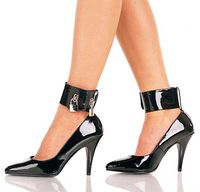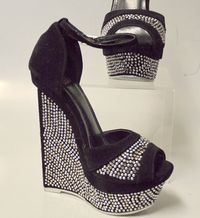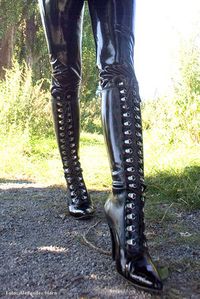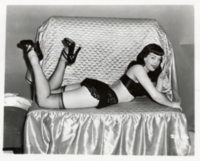High heels
High-heeled footwear (often abbreviated as high heels or simply heels) is footwear that raises the heel of the wearer's foot significantly higher than the toes. When both the heel and the toes are raised by roughly equal amounts, as in a platform shoe, it is not considered to be a "high-heel"; however, there are also high-heeled platform shoes. High heels tend to give the aesthetic illusion of longer, more slender and more toned legs.
According to high fashion shoe websites like Jimmy Choo and Gucci, a "low heel" is considered less than 2.5 inches (6 cm), while heels between 2.5 and 3.5 inches (8.5 cm) are considered "mid heels," and anything over that is considered a "high heel".
Although high heels are usually worn by girls and women, there are shoe designs worn by both genders that have elevated heels, including cowboy boots and Cuban heels. In the fetish scene, "female" high heels are often worn by men and women. They are particularly of interest to male cross-dressers and transvestites, who often regard them as particularly feminine.
Types of high heels
Types of heels found on high-heeled footwear include:
- cone: a round heel which is broad where it meets the sole of the shoe and noticeably narrower at the point of contact with the ground
- kitten: a short, slim heel with maximum height under 2 inches and diameter of no more than 0.4 inch at the point of contact with the ground
- prism: three flat sides which form a triangle at the point of contact with the ground
- spool: broad where it meets the sole and at the point of contact with the ground; noticeably narrower at the midpoint between the two
- stiletto: a tall, slim heel with minimum height of 2 inches and diameter of no more than 0.4 inch at the point of contact with the ground (from stiletto, a small dagger)
- wedge: occupies the entire space under the arch and heel portions of the foot
History
Raised heels are sometimes claimed to have been a response to the problem of the rider's foot slipping forward in stirrups while riding. The "rider's heel," approximately 1-1/2 inch (4 cm) high, appeared around 1500. The leading edge was canted forward to help grip the stirrup, and the trailing edge was canted forward to prevent the elongated heel from catching on underbrush or rock while backing up, such as in on-foot combat. These features are evident today in riding boots, notably cowboy boots.
The simple riding heel gave way to a more stylised heel over its first three decades. Beginning with the French, heel heights among men crept up, often becoming higher and thinner, until they were no longer useful while riding, but were relegated to "court-pony" wear. By the late 1600s, men's heels were commonly between three and four inches in height.
However, high heels may have been worn by women just as early or earlier, both as a fashion statement and to increase short stature. At least as early as 1533, the diminutive Italian wife of Henry II, King of France, Queen Catherine de'Medici, commissioned a cobbler to fashion her a pair of heels, both for fashion, and to suggest greater height. They were an adaptation of chopines and pattens (elevated wooden soles with both heel and toe raised, not unlike modern platform shoes or clogs and sabots), intended to protect the feet of the wearer from dirt and mud; but unlike chopines, the heel was higher than the toe and the "platform" was made to bend in the middle with the foot. That raised shoes had already been worn as a fashion statement in Italy, at least, is suggested by sumptuary laws in Venice that banned the wearing of chopine-style platform shoes as early as the 1430s.
Like many clothes worn by the rich, such shoes may have been worn because they would be impractical for manual labourers, hence were a status symbol to show that the wearer was not a manual labourer.
High-heeled shoes quickly caught on with the fashion-conscious men and women of the French court, and spread to pockets of nobility in other countries. The term "well-heeled" became synonymous with opulent wealth. Both men and women continued wearing heels as a matter of noble fashion throughout the seventeenth and eighteenth centuries. When the French Revolution drew near, in the late 1700s, the practice of wearing heels fell into decline in France due to its associations with wealth and aristocracy. Throughout most of the 1800s, flat shoes and sandals were usual for both sexes, but the heel resurfaced in fashion during the late 1800s, almost exclusively among women.
High heels today
Throughout the last 60 years high-heels have fallen in and out of favour several times, most notably in the late 90s, when lower heels and even flats predominated. Lower heels were preferred during the late 60s and early 70s as well, but higher heels returned in the late 80s and early 90s. The shape of the fashionable heel has also changed from block (70s) to tapered (90s), and stiletto (50s, 80s, and post-2000).
Today, high heels are typically worn by women, with heights varying from a kitten heel of 1½ inch (4 cm) to a stiletto heel (or spike heel) of 4 inch (10 cm) or more. Extremely high-heeled shoes, such as those higher than 5 inch (13 cm), are normally worn only for aesthetic reasons and are not considered practical. Court shoes are conservative styles and often used for work and formal occasions, while more adventurous styles are common for evening wear and dancing. High heels have seen significant controversy in the medical field lately, with many podiatrists seeing patients whose severe foot problems have been caused almost exclusively by high-heel wear.
Wedge heel is another style of the heel, where heel is in a wedge form and continues all the way to the toe of the shoe.
Reasons for not wearing high-heels include:
- they can cause foot pain
- they can create foot deformities, including hammertoes and bunions
- they can cause an unsteady gait
- they can shorten the wearer's stride
- they can render the wearer unable to run
- altered forces at the knee caused by walking in high heels may predispose to degenerative changes in the knee joint
- See "Foot and Tendon Problems" below for many of the medical reasons.
- Women who wear high heels frequently have a higher incidence of degenerative joint disease of the knees. This is because they cause a decrease in the normal rotation of the foot which puts more rotation stress on the knee
Reasons for wearing high-heels, which are almost exclusively aesthetic, include:
- they change the angle of the foot with respect to the lower leg, which accentuates the appearance of calves
- they change the wearer's posture, requiring a more upright carriage and altering the gait in what is considered a seductive fashion
- they make the wearer appear taller
- they make the legs appear longer
- they make the foot appear smaller
- they make the toes appear shorter
- they make the arches of the feet higher and better defined
- they make the lower leg muscles more defined
- they make the gluteal muscles more defined while wearing leggings or tight trousers
Both men and women regard women in high heels as more attractive; researchers "suggest that high heels may exaggerate the sex-specific aspects of the female walk which could cause sexual arousal in males and make women aware of potential competitors for mates." [1]
Men and heels
Although high heels originated in France as male footwear around 1500, since the late 1700s, men's shoes have had primarily low heels. A notable exception is cowboy boots, which continue to sport a taller riding heel. The two-inch Cuban heel features in many styles of men's boot, but was popularised by Beatle boots, famously worn by the English rock group, The Beatles, which saw the reintroduction of heels for men; some men still wear high heels today.
Winklepicker boots also usually feature a Cuban heel. There was also a brief resurgence in higher-heeled shoes for men in the 1970s; in Saturday Night Fever, John Travolta's character wears a Cuban heel in the opening sequence. The singer Prince is known to wear high heels.
In the fetish scene, high-heeled shoes are almost equally popular among men and women.
Accessories
Stiletto heels can damage some types of floors. Such damage can be prevented by heel protectors, also called covers, guards, or taps, which fit over the "stiletto" tips to keep them from direct, marring contact with delicate surfaces, such as linoleum rotogravure or urethane-varnished wooden floors. Heel protectors are widely used in ballroom dancing, as such dances are often held on wooden flooring. The bottom of most heels usually has a plastic or metal heel tip that wears away with use and can be easily replaced. [[Image:Balletboots.jpg|200px|thumb|right|Ballet Boots
Foot and tendon problems
High-heeled shoes slant the foot forward and down while bending the toes up. The more that the feet are forced into this position, the more it may cause the Achilles tendon to shorten. This may cause problems when the wearer chooses lower heels or flat-soled shoes. When the foot slants forward, a much greater weight is transferred to the ball of the foot and the toes, increasing the likelihood of damage to the underlying soft tissue which supports the foot. In many shoes, style dictates function, either compressing the toes, or forcing them together, possibly resulting in blisters, calluses, corns, hammer toes, bunions (hallux valgus), Morton's neuroma and many other medical conditions, most of which are permanent, and will require surgery to alleviate the pain. High heels — because they tip the foot forward — put pressure on the lower back through making the rump push outwards and crushing the lower back vertebrae and contracting the muscles of the lower back.
If it is not possible to avoid high heels altogether, some doctors suggest that the wearer spend at least a third of the time on their feet in contour-supporting "flat" shoes (such as exercise sandals), or well-cushioned "sneaker-type" shoes, saving high heels for special occasions.
One of the most critical problems of high-heeled-shoe design involves a properly constructed toe-box. Improper construction here can cause the most damage to one's foot. Toe-boxes which are too narrow force the toes to be "crammed" too close together. Ensuring that room exists for the toes to assume a normal separation, so that high-heel wear remains an option rather than a debilitating practice, is an important issue in improving the wearability of women's high-heeled fashion shoes.
Wide heels do not necessarily offer more stability, and any raised heel with too much width, such as found in "blade-" or "block-heeled" shoes, induces unhealthy side-to-side torque to the ankles with every step, stressing them unnecessarily, while creating additional impact on the balls of the feet. Thus, the best design for a high-heel is one with a narrower width, where the heel is closer to the front, more solidly under the ankle, where the toe box provides room enough for the toes, and where forward movement of the foot in the shoe is kept in check by material snug across the instep, rather than by the toes being rammed forwards and jamming together in the toe box, or crushed into the front of the toe box.
Despite the medical issues surrounding high-heel wear, a few podiatrists recommend well-constructed low to moderate heels for some patients. It appears a slight elevation of the heel improves the angle of contact between the metatarsals and the horizontal plane, thereby more closely approximating the proper angle and resulting in proper weight distribution of a medium-to-high-arched foot. Other foot specialists, however, argue that any heel causes unnecessary stresses on the various bones and joints of the foot.
Prettiness and health benefits
In 2008, Cerruto et al. reported results that appear to suggest that wearing high heels may improve the muscle tone of a woman's pelvic floor, thus reducing myofascial pelvic pain, relaxing the pelvic floor and improving pelvic organ well-being. The lead author, Dr. Maria Angela Cerruto of the Department of Biomedical and Surgical Sciences, Urology Clinic, University of Verona, Italy, writes that with her publication she wants to respond to an earlier article in the Daily Mail (29 October 2007) concerning the hypothesis that heeled footwear might cause schizophrenia. On a more personal note, Cerruto also writes "I like heeled shoes and although they are sometimes uncomfortable, I continue to wear them in an effort to appear more slender and taller."[2]. The original publication by Cerutto et al. can be found here. More recently, the Daily Mail says that high heels may be good for you. In short, researchers discovered that wearing a high heel may make women less likely to develop arthritic changes in the knee joint in later life. Hence, the diplomatic conclusion was that, at the very least, high heel wearers are no worse off than women opting for low-level footwear.
See also
| Portal:Clothing articles |
|---|
|



